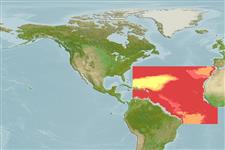>
Notacanthiformes (Halosaurs and deep-sea spiny eels) >
Halosauridae (Halosaurs)
Etymology: Aldrovandia: Taken from Ulisse Aldrovandi, (1522-1605), a Renaissance naturalist and physician noted by his systematic and accurate observations of plants and animals (Ref. 45335).
Eponymy: Dr Ulisse Aldrovandi (1522–1605) was an Italian naturalist. [...] (Ref. 128868), visit book page.
Environment: milieu / climate zone / depth range / distribution range
Écologie
marin bathypélagique; profondeur 1200 - 1900 m (Ref. 4448). Deep-water; 37°N - 9°S, 74°W - 6°W
Eastern Atlantic: Gulf of Guinea region. Western Atlantic: off Virginia, USA to Bahamas, Venezuela and the Guianas. Eastern Central Pacific (Ref. 9305) and Chile (Ref. 9068).
Taille / Poids / Âge
Maturity: Lm ? range ? - ? cm
Max length : 52.0 cm TL mâle / non sexé; (Ref. 4448)
Rayons mous dorsaux (Total) : 9 - 10. Anus white, surrounded by dark field; body dark brown, head black (Ref. 13608).
Found at bathyal depths. Feeds on polychaetes. Males exhibits black tubular anterior nostrils and enlarged posterior nostrils when approaching breeding condition.
Life cycle and mating behavior
Maturité | Reproduction | Frai | Œufs | Fécondité | Larves
Sulak, K.J., 1990. Halosauridae. p. 126-132. In J.C. Quero, J.C. Hureau, C. Karrer, A. Post and L. Saldanha (eds.) Check-list of the fishes of the eastern tropical Atlantic (CLOFETA). JNICT, Lisbon; SEI, Paris; and UNESCO, Paris. Vol. 1. (Ref. 4448)
Statut dans la liste rouge de l'IUCN (Ref. 130435: Version 2024-1)
Menace pour l'homme
Harmless
Utilisations par l'homme
Pêcheries: sans intérêt
Outils
Articles particuliers
Télécharger en XML
Sources Internet
Estimates based on models
Preferred temperature (Ref.
123201): 4.2 - 6.5, mean 4.3 °C (based on 37 cells).
Phylogenetic diversity index (Ref.
82804): PD
50 = 0.5156 [Uniqueness, from 0.5 = low to 2.0 = high].
Bayesian length-weight: a=0.00085 (0.00033 - 0.00223), b=3.07 (2.84 - 3.30), in cm total length, based on LWR estimates for this (Sub)family-body shape (Ref.
93245).
Niveau trophique (Ref.
69278): 3.1 ±0.26 se; based on food items.
Résilience (Ref.
120179): Faible, temps minimum de doublement de population : 4,5 à 14 années (Assuming tmax>10).
Fishing Vulnerability (Ref.
59153): Moderate vulnerability (41 of 100).
